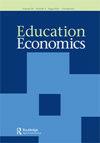Can teachers learn online? – evidence from Armenia during the COVID-19 pandemic
IF 0.9
Q3 Social Sciences
引用次数: 0
Abstract
ABSTRACTThe COVID-19 pandemic has forced a shift from traditional face-to-face instruction to online learning. We analyze how this shift has affected learning outcomes, using a rich data set from a financial literacy training of schoolteachers in Armenia. Online training worked well for relatively simple skills (acquiring theoretical financial knowledge) but less well than in-person training for more complex tasks (learning how to teach financial literacy to students). We also found that the deterioration of training success in the online cohort is stronger among social studies teachers than among math teachers. AcknowledgementsWe are very thankful to the editor and two anonymous referees whose comments helped us to substantially improve this paper. We are also grateful to Andrew Dustan, Kayleigh McCrary, Pedro Sant'Anna and Zaruhi Sahakyan, as well as attendees at the 2022 meeting of the Armenian Economic Association for helpful discussions, and to the staff of the Consumer Rights Protection and Financial Education Center, in particular Araks Manucharyan, for providing the data used in this article. The views expressed in this paper are those of the authors and do not necessarily represent the views or policies of the Central Bank of Armenia.Disclosure statementNo potential conflict of interest was reported by the author(s).Notes1 Even after the pandemic ends, online learning will have an important role in the future, as it can be more cost-effective (OECD Citation2020), or meet diverse learning needs (UNESCO Citation2020).2 Armenia has about 1420 primary and secondary schools, so each cohort consists of about 355 schools. The average school in Armenia is much smaller than in the United States, serving around 270 students in the relevant age range, and sending about 4 teachers to the financial literacy training.3 Almost all teachers also participated in the pre-test before the training took place. Those who did not (<10 across both years combined) were dropped from the dataset.4 The test questions contain a ‘don't know’ answer option.5 The 2020 Covid death rate was 1180 per million population in Armenia as a whole (1572 per million population in Yerevan). The 2021 Covid death rate was 1810 per million population in Armenia as a whole, and 2400 per million in Yerevan. Measured by these death rates, the pandemic was approximately 50% more severe in the in-person year 2021 than in the online year.6 Approximately 50 percent of our sample are ‘rich’ under this definition. Because teacher salaries are relatively flat, this variable depends mostly on the teacher's partner's income.7 For example, some clusters outside Yerevan are composed of schools from relatively urban areas, e.g. from the second-largest city, while other clusters contain primarily rural schools.8 Both the predicted and the actual pre-scores in 2021 are also quite close to the average pre-score of the 2020 cohort (46.3).9 Since teachers receive a salary that varies only slightly with job experience (except for teachers who are part-time), most of the difference in household income is due to the absence or presence of a second earner. The most plausible path how household income affects financial literacy is that richer households interact more with formal financial institutions (e.g. have savings accounts in banks).10 It is interesting to consider the results of a model without any demographic controls. While the treatment effect remains significantly negative (for TS and TMS; and insignificant for FLS), the size of the effect is reduced by about 10 to 25 percent, for example, for the first regression in Table 3, from −4.26 to −3.08; and, in the third regression, from −6.22 to −5.27. The direction of this change is intuitive because there are somewhat better types of teachers in the treatment group than in the control (e.g. there are more math teachers and more rich teachers in the treatment cohort). Thus, if we were not taking that change in the demographic composition into account, the size of the estimated negative online effect would be smaller.11 While positive correlations between general ability and gains from instructions have been reported (e.g. Kliegl, Smith, and Baltes (Citation1990); Kwon and Lawson (Citation2000); Verhaeghen and Marcoen (Citation1996)), negative correlations are also common (e.g. Gaultney, Bjorklund, and Goldstein (Citation1996); Traut, Guild, and Munakata (Citation2021)).教师可以在线学习吗?- 2019冠状病毒病大流行期间来自亚美尼亚的证据
新冠肺炎疫情迫使传统的面对面教学向在线学习转变。我们利用来自亚美尼亚教师金融知识培训的丰富数据集,分析了这种转变对学习成果的影响。对于相对简单的技能(获得理论金融知识),在线培训效果很好,但对于更复杂的任务(学习如何向学生传授金融知识),在线培训不如面对面培训好。我们还发现,在线队列培训成功的恶化在社会学科教师中比在数学教师中更强烈。我们非常感谢编辑和两位匿名审稿人,他们的意见帮助我们大大改进了本文。我们还要感谢Andrew Dustan, Kayleigh McCrary, Pedro Sant'Anna和Zaruhi Sahakyan,以及亚美尼亚经济协会2022年会议的与会者进行了有益的讨论,并感谢消费者权益保护和金融教育中心的工作人员,特别是Araks Manucharyan,为本文提供了使用的数据。本文中表达的观点是作者的观点,并不一定代表亚美尼亚中央银行的观点或政策。披露声明作者未报告潜在的利益冲突。注1即使疫情结束后,在线学习也将在未来发挥重要作用,因为它可以更具成本效益(OECD Citation2020),或满足多种学习需求(UNESCO Citation2020)亚美尼亚有大约1420所小学和中学,因此每个队列由大约355所学校组成。亚美尼亚的平均学校规模比美国小得多,大约有270名相关年龄段的学生,大约有4名教师参加了金融知识培训在培训开始前,几乎所有的老师都参加了预测试。那些没有达到这一目标的人(两年内的总和<10)从数据集中被删除试题中有一个“不知道”的选项2020年,亚美尼亚全国的新冠肺炎死亡率为每百万人1180例(埃里温为每百万人1572例)。2021年,亚美尼亚全国的新冠肺炎死亡率为每百万人1810例,埃里温为每百万人2400例。根据这些死亡率来衡量,2021年的大流行比在线年严重约50%根据这个定义,我们的样本中大约有50%是“富有的”。因为教师的工资是相对稳定的,这个变量主要取决于教师伴侣的收入例如,埃里温以外的一些组群由来自相对城市地区的学校组成,例如来自第二大城市的学校,而其他组群主要包括农村学校2021年的预估分和实际预估分也非常接近2020年的平均预估分(46.3分)由于教师的工资与工作经验的差异很小(兼职教师除外),家庭收入的大部分差异是由于没有或没有第二收入来源。家庭收入如何影响金融知识最合理的途径是,较富裕的家庭与正规金融机构有更多的互动(例如,在银行有储蓄账户)考虑一个没有任何人口控制的模型的结果是有趣的。虽然治疗效果仍然是显著负的(对于TS和TMS;并且对于FLS不显著),效应的大小减少了大约10%到25%,例如,对于表3中的第一次回归,从−4.26到−3.08;在第三次回归中,从- 6.22到- 5.27。这种变化的方向是直观的,因为治疗组的教师比对照组的教师更优秀(例如,治疗组有更多的数学教师和更富有的教师)。因此,如果我们不考虑人口结构的变化,估计的在线负面影响的大小将会更小虽然一般能力和从指令中获得的收益之间存在正相关的报道(例如Kliegl, Smith和Baltes (Citation1990);Kwon and Lawson (Citation2000);Verhaeghen和Marcoen (Citation1996)),负相关也很常见(例如Gaultney, Bjorklund和Goldstein (Citation1996);Traut, Guild, and Munakata (Citation2021))。
本文章由计算机程序翻译,如有差异,请以英文原文为准。
求助全文
约1分钟内获得全文
求助全文
来源期刊

Education Economics
EDUCATION & EDUCATIONAL RESEARCH-
CiteScore
2.00
自引率
8.30%
发文量
38
期刊介绍:
Education Economics is a peer-reviewed journal serving as a forum for debate in all areas of the economics and management of education. Particular emphasis is given to the "quantitative" aspects of educational management which involve numerate disciplines such as economics and operational research. The content is of international appeal and is not limited to material of a technical nature. Applied work with clear policy implications is especially encouraged. Readership of the journal includes academics in the field of education, economics and management; civil servants and local government officials responsible for education and manpower planning; educational managers at the level of the individual school or college.
 求助内容:
求助内容: 应助结果提醒方式:
应助结果提醒方式:


